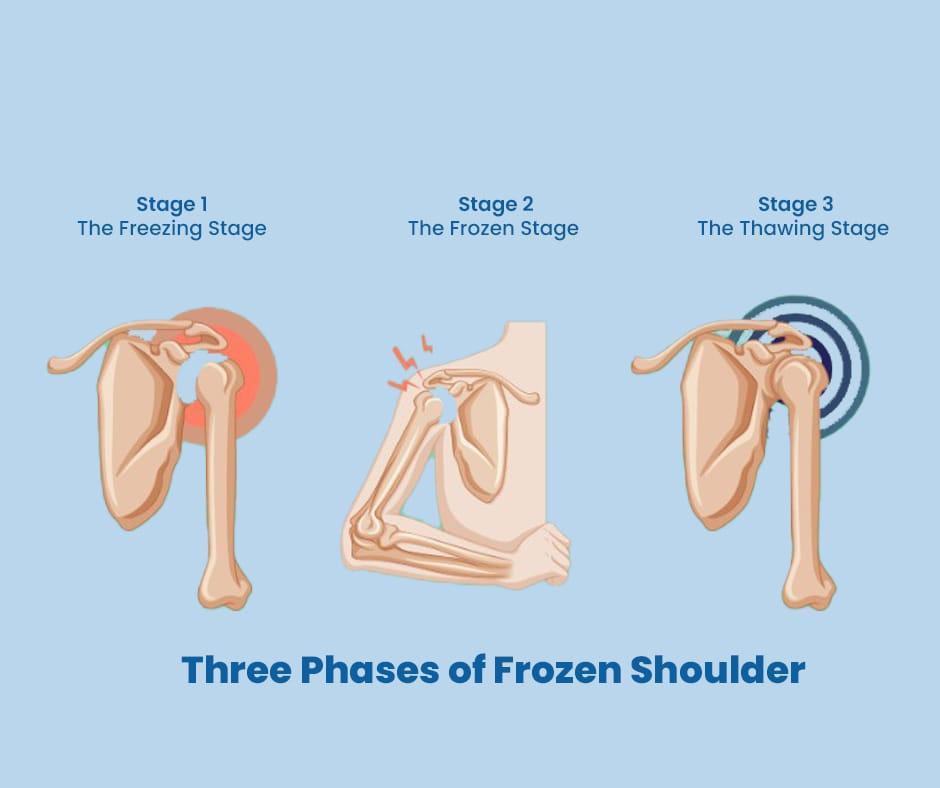Adhesive Capsulitis, another name for frozen shoulder, is a common ailment that affects the shoulder and results in discomfort, stiffness, and a restricted range of motion. Women are more likely to experience it than men, and it commonly affects people between the ages of 40 and 60. It can be irritating and fatal, making it difficult to go about everyday tasks or even to have a good night’s sleep.
The three stages of a frozen shoulder can be distinguished, each with particular symptoms:
Phase 1: Freezing Stage
The freezing stage is the first stage. A gradual emergence of shoulder pain and stiffness defines this period, which normally lasts between six to nine months. Usually felt in the upper arm or shoulder, the pain can be either dull or acute. The shoulder stiffens up more and more as the injury worsens, making it challenging to move the arm in any position.
The shoulder joint capsule starts to thicken and constrict at this stage, reducing the range of motion. Patients sometimes find this stage to be the most painful and irritating since they may find it impossible to complete even the most basic chores, including combing their hair or reaching up to an object on a high shelf.
The major goals of treatment at this point are to control discomfort and preserve a range of motion. Also, physical therapy helps keep the shoulder flexible and stops future stiffness.
Phase 2: Frozen Stage
The frozen stage is the second stage of a frozen shoulder. The pain levels normally plateau during this phase, which lasts four to six months, although the shoulder continues to be stiff. The shoulder capsule keeps getting thicker and tighter at this stage, which further reduces the range of motion.
Patients could find it challenging to reach behind their backs or elevate their arms above shoulder level. Sleeping might be difficult as well because it can be painful and uncomfortable to lie on the affected shoulder.
The goal of treatment at this stage is to improve flexibility in motion. With the addition of more vigorous stretching and strengthening activities, physical therapy may become more intense. Manual shoulder joint manipulation may be required in some circumstances to help break up scar tissue and improve mobility.
Phase 3: Thawing Stage
The thawing stage is the third and last step. A steady increase in range of motion and a reduction in pain characterize this phase, which normally lasts between six to nine months. This phase results in improved mobility as the shoulder capsule starts to sag and the scar tissue disintegrates.
Although some stiffness and soreness may still be present in the patient, it should be much less than in the earlier phases. Although regaining a full range of motion may take several months, patients should experience a gradual improvement in their shoulder pain.
Maintaining range of motion and avoiding a recurrence of a frozen shoulder are the main goals of treatment at this point. Physical therapy, stretching, and daily shoulder exercises can all be continued by patients in addition to their current regimen.
Conclusion
A frozen shoulder can be a frustrating and painful condition, but it is manageable with proper treatment. Shockwave therapy and regenerative injection therapy can help these patients to cure this condition. These treatments are innovative, non-surgical and without any side effects. The success rate is more than 95% and that’s amazing.
It is important for patients to work closely with their orthopedic doctor to develop a treatment plan that is tailored to their individual needs.

